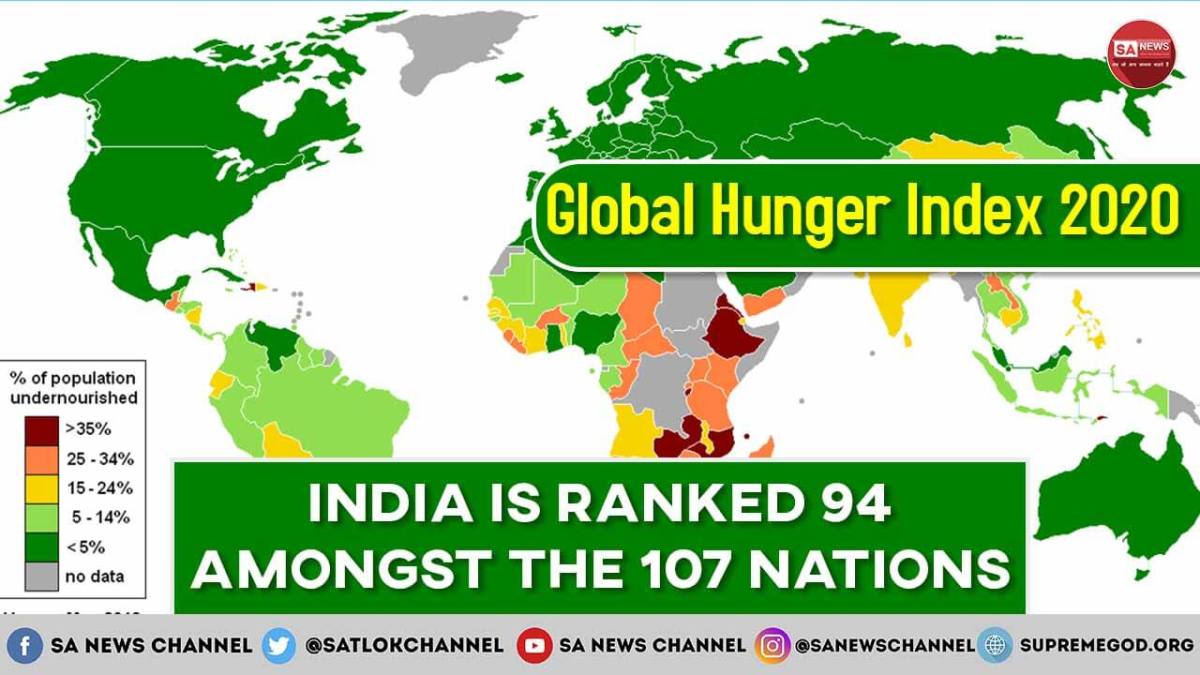
GLOBAL HUNGER INDEX 2020
WHY IN NEWS?
- India has been ranked at 94 among 107 countries in the Global Hunger Index (GHI) 2020.
ABOUT INDEX
- Jointly published by Concern Worldwide and Welthungerhilfe
- It was first produced in 2006. It is published every October. The 2020 edition marks the 15th edition of the GHI.
CALCULATION:
- The GHI scores are calculated each year to assess progress and setbacks in combating hunger. It is calculated on the basis of four indicators:
- Undernourishment: Share of the population with insufficient caloric intake.
- Child Wasting: Share of children under age five who have low weight for their height, reflecting acute undernutrition.
- Child Stunting: Share of children under age five who have low height for their age, reflecting chronic undernutrition.
- Child Mortality: The mortality rate of children under the age of five.
GLOBAL SCENARIO
- Worldwide Hunger: Represented by a GHI score of 18.2 (moderate level), down from a 2000 GHI score of 28.2 (serious).
FACTORS:
- The Covid-19 pandemic and the resulting economic downturn, as well as a massive outbreak of desert locusts in the Horn of Africa and other crises, are exacerbating food and nutrition insecurity for millions of people.
- It needs to be noted that 2020 GHI scores do not reflect the impact of Covid-19 on hunger and under nutrition.
- The above mentioned crises come on top of existing hunger caused by conflict, climate extremes, and economic shocks (random, unpredictable events).
- Region-wise Performance: Africa South of the Sahara and South Asia have the highest hunger and under nutrition levels among world regions, with 2020 GHI scores of 27.8 and 26.0, respectively—both considered serious.
INDIAN’s OVERALL PERFORMANCE:
- With a score of 27.2, India has a level of hunger that is “serious”.
- It ranks 94 out of 107 countries in the Index. In 2019, India’s rank was 102 out of 117 countries.
- Comparison with Other Countries:
- India features behind Nepal (73), Pakistan (88), Bangladesh (75), Indonesia (70) among others.
- Out of the total 107 countries, only 13 countries fare worse than India including countries like Rwanda (97), Nigeria (98), Afghanistan (99), Liberia (102), Mozambique (103), Chad (107) among others.
INITIATIVES TO COUNTER THE TREND
- Eat Right India Movement: An outreach activity organised by the Food Safety and Standards Authority of India (FSSAI) for citizens to nudge them towards eating right.
- POSHAN Abhiyaan: Launched by the Ministry of Women and Child Development in 2018, it targets to reduce stunting, undernutrition, anemia (among young children, women and adolescent girls).
- Pradhan Mantri Matru Vandana Yojana: A centrally sponsored scheme executed by the Ministry of Women and Child Development, is a maternity benefit programme being implemented in all districts of the country with effect from 1st January, 2017.
- Food Fortification: Food Fortification or Food Enrichment is the addition of key vitamins and minerals such as iron, iodine, zinc, Vitamin A & D to staple foods such as rice, milk and salt to improve their nutritional content.
- National Food Security Act, 2013: The National Food Security Act, (NFSA) 2013 legally entitled up to 75% of the rural population and 50% of the urban population to receive subsidized food grains under the Targeted Public Distribution System.
- Mission Indradhanush: It targets children under 2 years of age and pregnant women for immunization against 12 Vaccine-Preventable Diseases (VPD).
- Integrated Child Development Services (ICDS) Scheme: Launched on 2nd October, 1975, the Integrated Child Development Services (ICDS) Scheme offers a package of six services (Supplementary Nutrition, Pre-school non-formal education, Nutrition & health education, Immunization, Health check-up and Referral services) to children in the age group of 0-6 years, pregnant women and lactating mothers.
